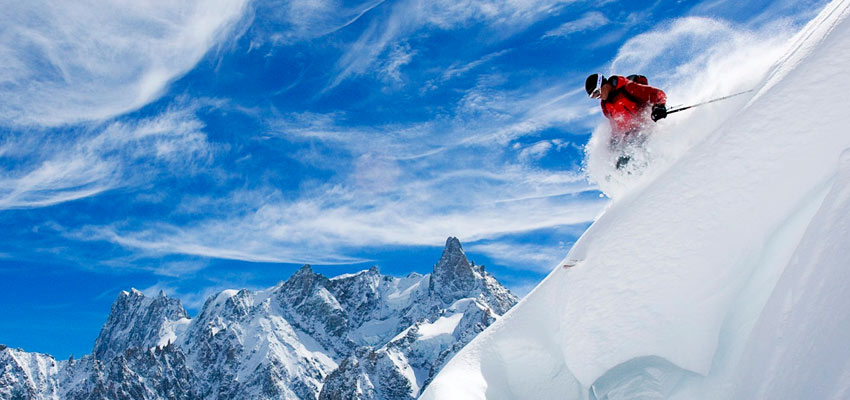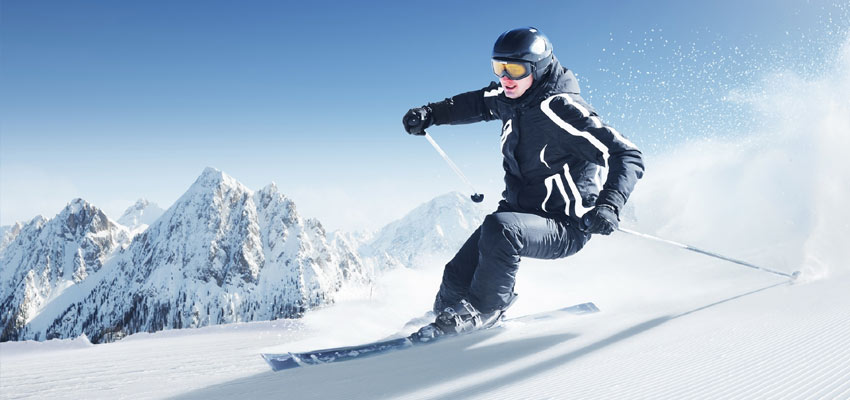What to wear when skiing!
The ski season is now well underway so if you’re looking to get involved, you’ll need to know what to wear – to ensure that you’re dressed appropriately!
Whilst skiing, dressing in layers is definitely the best approach. Instead of wearing a couple of warm items, wearing many layers results in you having the option to add or remove layers depending on the time of day and temperature – helping you to feel good.
The first item to include is a baselayer, which is the closest layer to your skin. You can get performance tops and long bottom baselayers, which help to cover a large surface area of your body. It is important to make sure that you wear a baselayer that is made from a wicking material – natural fibres such as merino wool and materials such as synthetic polyester and polypropylene are popular – as these are excellent at keeping your skin dry (and their softness keeps you comfortable).
Midlayers should also be made of a wicking material, to keep any sweat and moisture away from the skin. Typical midlayers include items of clothing such as sweaters and fleeces, with fleece and wool being common materials.

The outer layer items include jackets and pants, which should both have a waterproof and breathable shell. These items can vary a lot, with a multitude of features available for them, including the abilities to be insulated and vented – even aspects such as the number of pockets can differ substantially.
Besides the primary layering system, it is important to keep other parts of your body as warm and comfortable too! We lose a lot of heat through our heads, so a hat or (even better) a helmet will help to retain some of that. Helmet’s also double up as protection, so make sure that yours fits snugly and securely – and doesn’t wobble when you shake your head! As well as your head, protect your face and neck with a balaclava or a face mask – or just a neckwarmer if you don’t mind leaving your face exposed!
Balaclavas and face masks cover the majority of your face, but not your eyes (as you still need to see!) Goggles are used to protect your eyes from harmful UV rays, wind and snow – as well as help with the lighting. They also contribute to keeping your face warm.

Your hands can be shielded from the elements by both gloves and mittens. Mittens will keep your hands a little bit warmer than gloves as your fingers are bunched together, but some gloves (and mittens) even have pockets for hand warmers, which will help to keep your hands and fingers nice and toasty. A quick tip: pull the sleeves of your jacket over your gloves, so that no snow or rain can slide down your arm and into your glove – you wouldn’t like that!
The only thing inside your (waterproof and insulated) ski boots should be ski socks – which need to be fully extended and tight, with no creases. Make sure that you always pull your trousers over your boots!
Although it’s not an item of clothing, it’s recommended that you always apply sun cream – even on cloudy days – because your skin still needs protecting from the sun’s damaging rays; which reflect off the snow and can be up to twice as strong.
Our full range of winter sports products are available on our website now at discounted prices. Orders over the cost of £50 receive free shipping. If you have any questions, please do leave a comment below or message us on Facebook or Twitter!
Categories
- Sport (28)
- Product Reviews (3)
- Team Outdoor Look (7)
- Mike Wild (2)
- Mike Payton (2)
- Suse Hammond-Pears (3)
- Snowboarding (12)
- Latest Offers (105)
- Shop Talk (1)
- Competitions (7)
- Walking (413)
- Lifestyle Fashion (8)
- Travel (86)
- Kit Guides (176)
- Workwear Clothing (6)
- Safety Workwear (4)
- Health/Fitness (289)
- Skiing (91)
- Great Outdoors (1316)
- Cycling (92)
- January 2025
- December 2024
- November 2024
- October 2024
- September 2024
- August 2024
- July 2024
- June 2024
- May 2024
- April 2024
- March 2024
- February 2024
- January 2024
- December 2023
- November 2023
- October 2023
- September 2023
- August 2023
- July 2023
- June 2023
- May 2023
- April 2023
- March 2023
- February 2023
- January 2023
- December 2022
- November 2022
- October 2022
- September 2022
- August 2022
- July 2022
- June 2022
- May 2022
- April 2022
- March 2022
- February 2022
- January 2022
- December 2021
- November 2021
- October 2021
- September 2021
- August 2021
- July 2021
- June 2021
- May 2021
- April 2021
- March 2021
- February 2021
- January 2021
- December 2020
- November 2020
- October 2020
- September 2020
- August 2020
- July 2020
- June 2020
- May 2020
- April 2020
- March 2020
- February 2020
- January 2020
- December 2019
- November 2019
- October 2019
- September 2019
- August 2019
- July 2019
- June 2019
- May 2019
- April 2019
- March 2019
- February 2019
- January 2019
- December 2018
- November 2018
- October 2018
- September 2018
- August 2018
- July 2018
- June 2018
- May 2018
- April 2018
- March 2018
- February 2018
- January 2018
- December 2017
- November 2017
- October 2017
- September 2017
- August 2017
- July 2017
- June 2017
- May 2017
- April 2017
- March 2017
- February 2017
- January 2017
- December 2016
- November 2016
- October 2016
- September 2016
- August 2016
- July 2016
- June 2016
- May 2016
- April 2016
- March 2016
- February 2016
- January 2016
- December 2015
- November 2015
- October 2015
- September 2015
- August 2015
- July 2015
- June 2015
- May 2015
- April 2015
- March 2015
- February 2015
- January 2015
- December 2014
- November 2014
- October 2014
- September 2014
- August 2014
- July 2014
- June 2014
- May 2014
- April 2014
- March 2014
- February 2014
- January 2014
- December 2013
- November 2013
- October 2013
- September 2013
- August 2013
- July 2013
- June 2013
- May 2013
- April 2013
- March 2013
- February 2013
- January 2013
- December 2012
- November 2012
- October 2012
- September 2012
- August 2012
- July 2012
- June 2012
- May 2012
- April 2012
- March 2012
- February 2012
- January 2012
- December 2011
- November 2011
- October 2011
- September 2011
- August 2011
- May 2010
- April 2010
- March 2010
- February 2010
- January 2010
- November 2009
- October 2009
- September 2009
Submit a Comment